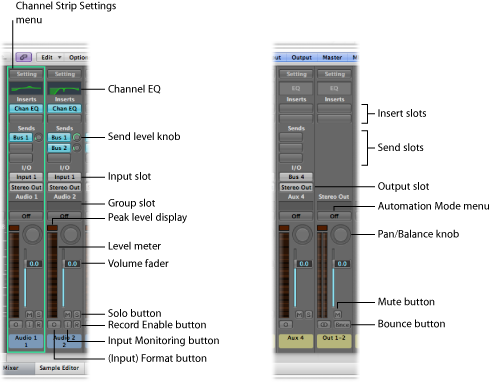Understanding Channel Strip Controls in the Mixer
The controls displayed on a channel strip vary according to the channel strip type:

- Channel Strip Settings menu: Allows you to load and save the entire routing configuration of a single channel strip, including all loaded plug-ins and settings. For details, see Working with Channel Strip Configurations.
- Channel EQ: Allows you to add an EQ effect to sculpt the sound of the channel strip signal before applying other effects. You double-click the EQ area to insert the Channel EQ in the first Insert slot.
- Insert slots: Allow you to insert up to 15 effect plug-ins into each audio, instrument, aux, and output channel strip.
- Send slots: Used to route a channel strip’s signal to an aux channel strip. Sends are commonly used to apply the same effect or effects to several signals.
- Send level knob: Used to control the amount of signal sent to an aux channel strip. This knob appears when a Send slot is activated.
- Input slot: Sets the channel strip’s input source. Depending on the channel strip type, it can be a physical input, a bus, or a software instrument plug-in—in this case it is known as an Instrument slot.
- Output slot: Sets the channel strip’s output path. It can be a physical output or a bus.
- Group slot: Controls a channel strip’s group assignment and provides access to the Group Settings window.
- Peak level display: Updates during playback to show the highest peak level reached.
- Pan/Balance knob: On a mono channel strip, the Pan/Balance knob controls the position of the signal in the stereo image. On a stereo channel strip, it controls the relative level of the left and right signals at their outputs.
- Level meter: Displays a channel strip’s playback or input monitoring level.
- Volume fader: Sets a channel strip’s playback or monitoring volume.
- Solo button: Solos and unsolos the channel strip.
- Mute button: Mutes and unmutes the channel strip.
- (Input) Format button: Defines a channel strip’s input format (mono, stereo, or surround). For details, see Setting Channel Strip Input Format.
- Input Monitoring button: Allows you to hear incoming audio on audio tracks that are not armed for recording. See Enabling Software Monitoring for Recording.
- Record Enable button: Arms a channel strip for recording.
- Bounce button: Bounces the output of any output channel strip to an audio file.
- Automation Mode menu: Sets a channel strip’s automation mode.
Tip: You can hide or show channel strip elements in the Mixer (EQ Thumbnails, Inserts, Sends, I/O, Type and Number Label, Track Name, Track Number, Control Surface Bars, Notes) by disabling and enabling their settings in the View menu.